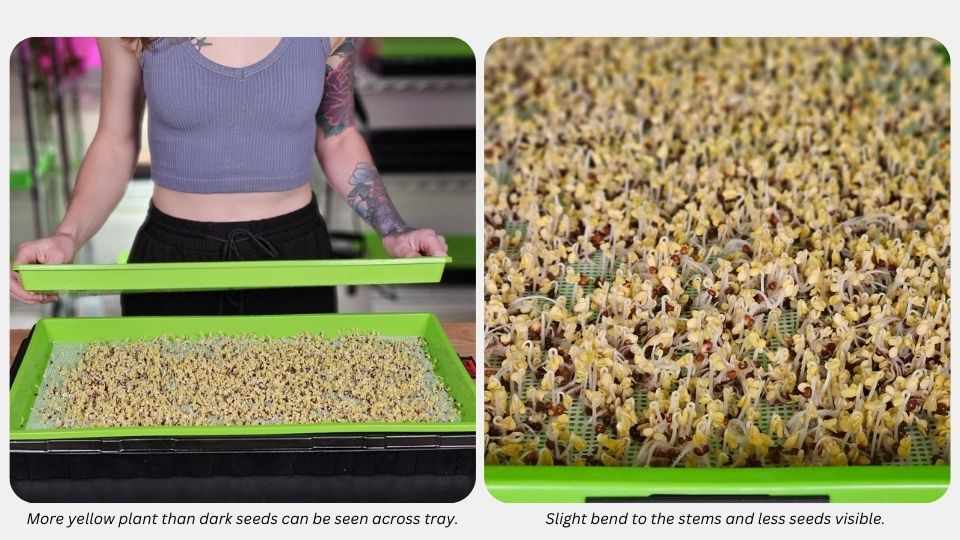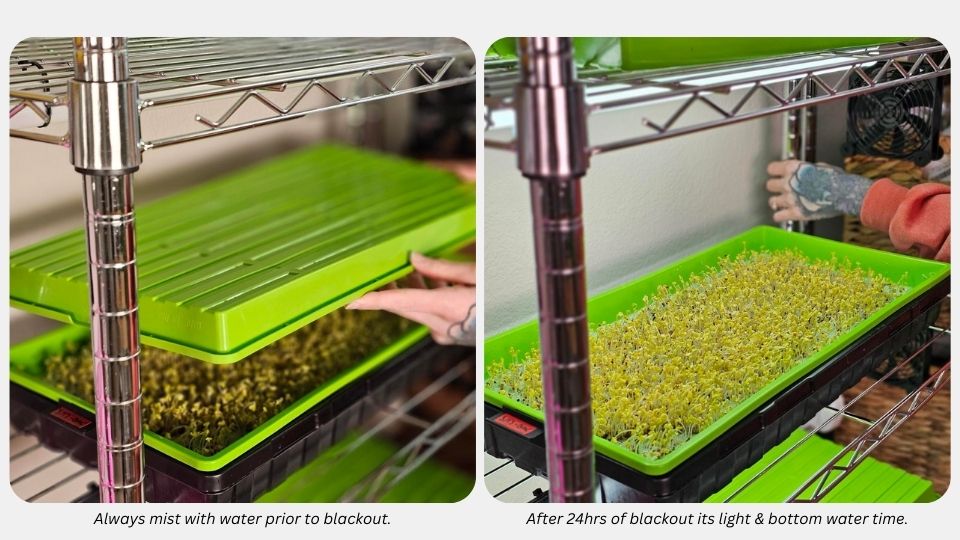Unlocking the Secret: Knowing the Right Time to Transition Microgreen Trays from Weight to Blackout
One of the things people always ask us about growing Microgreens is why we add weight during germination and what's up with blackout. Most importantly, how do you know when it's time to switch between either of these two steps??
Guess what? Today, we're gonna share with you how we visually figured out the perfect timing for each step of the Microgreen germination process, without having to keep track of which day we are on, first, lets go over what these two terms mean.
Weight vs Blackout
What it means to add Weight to Microgreens:
Using weight is the simple act of placing something ontop of your microgreen seeds during their germination phase to add resistance and help trap humidity. To achieve adding weight successfully to your microgreen grows, we suggest using an object that can help to evenly distribute pressure, like a tray. Optionally, you can add weight to the tray ontop of the microgreen seeds during their germination. For most crops we tend to use roughly 7lbs of weight, whereas stronger varieties like sunflower microgreens which can easily lift up to 15lbs.
What it means to put Microgreens into Blackout:
Blackout is the act of restricting the plants from light by using an object that does not apply weight to the microgreens. A common object used is a reversed tray of similar size on-top to create a dome that blocks most, if not all access to light.
Why do either of these steps?
Weight
By adding weight on-top of your germinating Microgreen seeds during their first few days of growth you are opening yourself up to three major benefits:
1) Seed shell removal - the addition of weight gives the freshly sprouted seedlings something to help push against and remove those seed shells across the tray. That's why in our photos and videos across social media, you usually don't see lots of seeds still attached to the leaves, even with sunflower, which is notorious for clingy seed shells.
2) Stronger stems - whenever your microgreens are pushing up against the weight, they are also giving their stems a workout! Its pretty wild to witness a tray of sunflower microgreens completely lifting 15lbs! Just like us going to the gym, resistance is something that can benefit microgreens, and it happens natrually in nature too.
3) Even germination - we also noticed that the addition of weight generally helps increase the germination across our trays! We conducted an experiment back in 2020 on this topic that you can visually see the results if your curious! This makes sense as it helps to trap in humidity, which is great for germinating seeds.
Blackout
After you get through the weighted period of germination, its time to move your tray into blackout. Here are the top three benefits to putting your microgreen trays into blackout:
1) Taller crops - because the plants stretch and grow their stems in search of light, you end up with a slightly taller crop. (go too long and they will become unhealthy looking and fall over, unable to support their own weight... so find a healthy balance)
2) Easier harvest - this plays into the first benefit, the extra amount of stem height allows for more room to harvest, and is extremely helpful to get a few extra centimeters for super short crops like Basil.
3) Higher harvest weight - with a slight stem boost, you can also gain a little extra harvest weight! We don't suggest over-doing it though, as most customers we had prefered the medium-length stems for appearance.
When's the right time?
Weight
Choosing the right time to remove your germinating seeds from under weight, and flip your top tray into a dome for blackout is really quite easy since they will visually tell you that it's time. Here's the key things we look for:
1) More yellow plant than dark seed hulls across the tray - this is THE MOST important tell-all that it is indeed time! If the grow looks like the seeds are still attached to most of the sprouts, it is not time.
2) Stems slightly bending - you do not want to allow this to happen for too long.
Your tray should look something like this when its time to remove the weight:

Blackout
After you get through the weighted period of germination, its time to move your tray into blackout. Here is the main benefit:
Taller crops - because the plants stretch and grow their stems in search of light, you end up with a slightly taller crop. As previously mentioned, this makes harvesting day easier, especially for those super short crops.
While it can be good to use blackout to help gain a little height, its also important to note that some crops may not need it at all, and there is such thing as too long of a blackout. Our general rule of thumb is no more than 24-hours for most crops. The goal is to get some height without becoming so tall that they are falling over. However if you'd like to learn more about the timing, Check out our Free PDF Downloads, we share this information in our Free Microgreen Seeding Guides.
Fun Fact: The same affect can be achieved with a clear dome too, except instead of restricting the light, you are using the humidity within the dome along with the heat to stretch them. This is the method we use for our 7x14 Tray Kit.

Conclusion
We hope that this helped to shine some light on timing out the beginning of your germination phase for you microgreens. It's important to note, that during these steps we always make sure to water 1 to 2 times per day, as this also helps with keep your trays germinating correctly, as well as boosting things like the seed hull removal. If you're curious where to buy the items seen in the photos, we have a wonderful collection of products here on our website, such as the trays.Happy growing from our home to yours,
On The Grow founders: Mandi & CJ

A lot of my seeds have not germinated after 3 days…Should be time to move to black out but…lots of good roots from the seeds that did germinate…what did i do wrong?
Great info and progressive ideas, as usual. Thanks. San